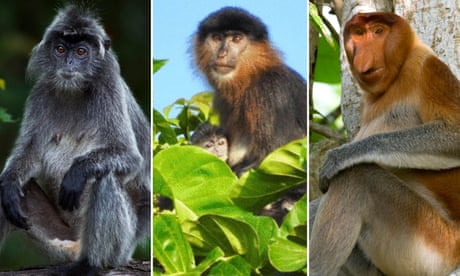The emergence of a “mystery monkey”, believed to be a rare hybrid of two distantly related primates, highlights the importance of protecting habit connectivity, according to a researcher who studied the animal. The female monkey first attracted attention in 2017, when photographs taken of it along the Kinabatangan River in Sabah, Malaysia , were uploaded to social media wildlife photography groups. Researchers studied various photographs taken of the monkey, looking at its colouring and proportions, and concluded it is likely the offspring of a male proboscis monkey ( Nasalis larvatus) and a female silver langur ( Trachypithecus cristatus).
They observed that the monkey’s face was closer to that of a proboscis monkey than silver langur, though its nose, while pronounced, was not as long, and its skin was grey. Its hair, long and dense, resembled that of a silver langur, though it did not have a side mane as is common for the species, and its colour showed patterns typical for a proboscis monkey. Observers told researchers they had seen mixed-species groups in the area, and interspecific mating had been photographed.
A. Juvenile ‘mystery monkey’ near Kampung Bilit, Kinabatangan, Sabah, groomed by adult female Trachypithecus cristatus (likely the mother). B.
Subadult ‘mystery monkey’ alone. C. Subadult ‘mystery monkey’ alone, feeding.
D. Subadult ‘mystery monkey’ with juvenile T. cristatus , adult female T.
cristatus , and another T. cristatus individual while grooming. E.
Adult male Nasalis larvatus mating with adult female T. cristatus in the same area. F.
Adult putative hybrid now clearly identifiable as female with swollen breasts, holding an infant, which appears to be her offspring. Composite: Ken Ching, Ben Duncan Angkee, Bob Shaw, Ben Ching, Jean-Jay Mao, Nicole Lee/International Journal of Primatology Researchers say the case may be related to habitat loss and fragmentation as oil palm plantations have expanded, confining the two putative parent species to narrow riverine forest patches along the Kinabatangan. Interspecies mating can occur if groups of both parent species are confined in a small space, said Nadine Ruppert, primatologist and senior lecturer at Universiti Sains Malaysia, who co-authored a study of the animal, which was published in the International Journal of Primatology in April , though she said further research was needed to examine the home range of both parent species.
“It’s hard to assess if the groups are ‘trapped’ within this small fragmented habitat patch that is surrounded by river, oil palm [plantations] and settlements [and] roads, or if they can disperse further upriver to the close-by intact forest,” she said. Regardless, she added: “Habitat loss and fragmentation in general is always a threat to wildlife populations and should always be mitigated or avoided. ” A previous study found dramatic reductions in forest cover in the area over recent decades: Sabah lost 39.
5% of its forest area between 1973 and 2010. If habitat degradation is indeed to blame, this could mean the adult males of the proboscis monkeys, unable to disperse to other areas to find mating partners of their own species, instead take over silver langur harems, Ruppert said. “Then probably one species might become locally displaced in these patches of low habitat quality, as it will be outcompeted by the more dominant species.
” Sign up to First Edition, our free daily newsletter – every weekday morning at 7am BST Local organisations and NGOs are already actively working on re-establishing habitat connectivity, said Ruppert. This includes building canopy bridges, initially designed for orangutans but used by different tree-dwelling species, and planting forest trees across the mixed oil palm plantation-forest landscape that will serve as wildlife corridors, especially for elephants. “These habitat restoration projects are of utmost importance for many threatened species and if habitat fragmentation is not mitigated and worsens, we can expect that many charismatic species will go locally extinct in the future, as demonstrated by the case of the Sumatran rhino in the area,” said Ruppert.
“I think the case should highlight the importance of habitat connectivity to the public and governments,” she added. The putative hybrid, now an adult female, and was last photographed in September 2020 with an infant. .
From: theguardian
URL: https://www.theguardian.com/science/2022/jun/12/malaysia-mystery-monkey-habitat-loss-proboscis-monkey-silver-langur



